(click on photos to enlarge image)
THE ENGLISH SILVER CASTER
It seems that the human race has always had a need to
sweeten the food we eat and for centuries, although sugar was
imported into England from at least the 16th.century, this was
achieved, for most people, by using honey which was produced
within the country's own shores.
With the founding of the West Indian sugar plantations c1642
(Barbados had been settled in 1626), however, sugar soon became
the preferred agent for sweetening all sorts of food and by the
end of the 17th century, when the tonnage of sugar imported had
risen from less than 800 tons a year in 1665 to 10,000 tons
(note 1) it was not
only being put into food, and used to make all sorts of
confections and cordials, but was being shaken over it as well.
To accommodate this particular use of sugar a suitable vessel
for dispensing it in this way was required. Sugar had always
been kept in sugar boxes which were the Elizabethan forerunners
of the bowls, baskets and vases of the 18th century and
although pepper was sometimes kept in the small detachable top
of the bell salt, casters, as such, did not appear until after
the "Restoration". When they did appear they were for "casting"
sugar not pepper.
I have read of Charles II casters but have only
ever seen a photograph of one. I feel that they must
be very rare indeed.
The earliest example one is likely to come across is
of the William III period, and these are very few
and far between.
They were usually quite large and simple in
construction being nothing more than a cylinder
standing on a small foot rim. The detachable pierced
top is secured by means of a bayonet fitting and is
surmounted by a cast finial which is usually of the
baluster type.
The method of manufacture appears to have been to
fold a sheet of silver round to form the cylinder
and then seam the ends together so that it may be
possible to detect this seam, if not on the outside
then on the inside. These casters are known as
Lighthouse casters. It seems that subsequent
patterns of caster were not made in this way.
(right) Lighthouse Caster by "CA", London
1693
|
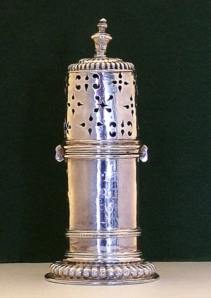 |
The body is usually undecorated save for armorials although
the tops and foot rims are often given some decorative ropework
feature; foot rims can also be pierced. They are fully marked
just below the joint of top and body and the tops should be
marked with the maker's mark and the sterling lion or lion's
head erased. The piercing is fretted out by hand and consists of
rather large apertures which are simple and not terribly
decorative.
It is interesting to note that hallmarking of this period was
looked on as a legal necessity but no other importance was
attached to it as it is today. It seems that objects which were
destined for the piercer were sent up for marking before
piercing took place and no care was taken by the piercer to
avoid the marks which had been put on at "Hall" so that often
these marks were cut through. The sterling lion, the only mark
on the top of the lighthouse caster illustrated here, has been
so treated and only the front half of this mark is now
discernible!
There is no reason why sugar of the day could not have been as
fine as that which we are used to and it is therefore difficult
to know why the apertures on casters are relatively large.
Casters of this period are quite rare and difficult to come by
so that an example with a bent finial must be considered
acceptable.
By the end of the 17th century both pepper and cayenne were
being used at table and these too required casters. As the large
sugar caster was already being produced it seemed logical to
make smaller versions of the same thing to dispense these
peppers and silversmiths began producing casters in sets of
three. One large one for sugar and two matching smaller ones for
pepper and cayenne respectively. Sets of three lighthouse
casters are vary rare indeed!
(note 2)
Although these casters were still being made at the beginning of
the 18th century the simple piercing of a lighthouse caster will
date it to the 17th since, conveniently, piercing became more
complicated during the reign of Queen Anne.
The Queen Anne caster, which, like other Queen
Anne hollow-ware, is portly in appearance (there are
Queen Anne lighthouse casters) did not evolve from
its forerunner, as future casters did from theirs,
and the only thing to relate it to the lighthouse
caster is the method of securing the top.
At the beginning of the reign it too had bayonet
fittings but by the end of the reign the top was
just a push fit and this method of securing the tops
of casters remained unchanged throughout the century.
(right) Queen Anne caster by Charles Adam
London 1713/14
|
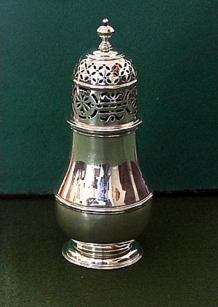 |
The only other change which took place during the life of
this particular caster was that the early ones were marked, like
the lighthouse variety, on the body just below the joint of top
and body whereas the later ones were marked underneath.
One feature which is peculiar to these casters, however, is that
the top is constructed, as if in two parts, with a strengthening
band running horizontally round its middle. This feature is
peculiar to this caster and does not appear on the lighthouse
variety or on those which come after the reign of Queen Anne.
The piercing is still rather large, is hand fretted and, being
somewhat more ambitious in concept than that of the earlier
examples, can be quite decorative. The shape of these casters is
usually known as pyriform and it can easily be seen how the next
shape evolved from it. The top of the Queen Anne caster is
marked on the sleeve which pushes into the body of the vessel
and secures it although the earliest have bayonet fittings. This
method of marking tops was common to all casters throughout the
18th century.
By the reign of Geo I the neck of the caster was
becoming elongated and the body was raised slightly
on a domed foot so that the whole thing presented a
much more elegant appearance.
This design is known as the vase shape and persisted
throughout the reign of Geo II and into that of Geo
III.
One variation which is peculiar to Geo I casters,
almost exclusively, is that they are usually
octagonal in form.
(right) George I caster of octagonal vase
shaped form by Samuel Welder London 1725/6
|
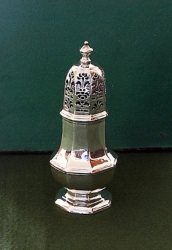 |
The piercing of the top is now much more complicated and
commensurately more decorative. Otherwise they are much like
their precursors in that they are, on the whole, undecorated
except for armorials and are fully marked underneath with the
tops being marked at least with the sterling lion and / or the
maker's mark.
Although baluster finials were common throughout the 18th
century those of the queen Anne and George I periods can take
the form of a ball with a pip at the top which I have described
as "bun and knop". Finials of this design are peculiar to the
beginning of the century.
By the second half of the century acorn and flame finials had
made their appearance but were not as common as the baluster
type. An even less common design is the pineapple but examples
can be found. By the end of the 18th century a simple ball
finial had been introduced and this can be found on both the
conventional caster and on those being made of glass as well as
on some other small hollow-ware.
In the same way that the bun and knop finial is common only at
the beginning of the 18th Century the ball finial is found
mostly at its end. I have seen a ball on a sort of collared neck
on a caster of 1745 but this is quite unusual.
Conveniently the pyriform design more or less coincided with the
reign of Queen Anne and the octagonal vase shape with that of
Geo I ( the earliest octagonal I have seen is dated 1713 ) but,
whilst the vase shape persisted throughout the reign of Geo II
and into that of Geo III, the octagonal appearance disappeared
at about the beginning of the reign of Geo II.
The finials on Geo II casters were commonly of
the baluster shape and the piercing took on a new
appearance.
It took the form of alternating vertical bands of
ornate piercing of the type used in the Geo I
version and rows of simple holes punched through an
engraved diaper background.
(right) Vase shaped Caster by Charles Alchorn
London 1734/5
|
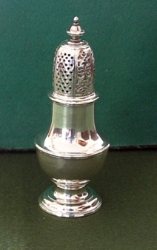 |
It is convenient that this arrangement of alternating bands
of piercing coincides, more or less, with the beginning of the
reign of Geo II and persisted well into that of Geo III and so
can help when dating a caster although it must be said that some
casters were still being produced during this period with only
the decorative piercing common to earlier examples and some,
even, with nothing but simple holes.
It seems likely that either the piercing was carried out by
specialists in the field, the belief most widely held, or that
standard pattern books of the day were used since almost all
casters of this period exhibit this design feature no matter who
the maker was. My own belief is that there were craftsmen
specialising in this piercing work and that they used each
other's pattern books (note
3).
Another innovation at this time (the earliest I have seen was
dated 1726) was the introduction of the blind caster. One of the
pair of pepper casters would have a sleeve inserted behind the
piercing so that it was, in effect, not a caster at all. Most
authorities are of the opinion that such "casters" were designed
to contain dry mustard and it is true that at about the time
that these "casters" came into use the condiment spoon, which
would have been needed to dispense the contents, made its
appearance. These little long handled spoons are not common!
There is a record of such a spoon by an unidentified maker "FG"
found together with a blind caster also by "FG" and this
supports the theory that, whatever blind casters were made to
contain, a suitable spoon was needed with them. As there is no
record to suggest that pepper was no longer used one must assume
that the habit of using mustard in this way superseded the use
of cayenne. To support the view that these blind casters were
for mustard it must be observed that their production stopped at
about the time that the mustard pot came on the scene.
The collector is, in fact, more likely to come across the half
blind caster in which the sleeve is itself pierced but in such a
way as to restrict considerably the flow of the contents or
alternatively is designed to cover only some of the piercing.
It is true that the sleeving of such casters can be
contemporaneous but I feel that it is possible that in some
cases these casters were adapted in this way at a later date to
make them more useful when a finer grind of pepper became
common. My reason for this view is that there are casters of the
period which were made ‘blind’ with the pattern of the piercing
engraved onto the top to match its pierced partner and this
suggests that any adaptation of an ordinary caster must be of a
later date. It is a fact that the largest, sugar, caster in a
set of three was not treated in this way.
As with earlier casters these sometimes are decorated with
armorials but are unlikely to carry any other decoration. They
are fully marked under the foot and the tops are marked with a
variety of the marks found under the foot but never with the
leopard head.
In connection with marking it appears that only one set of
punches was used for marking both top and body so that the
sterling lion stamped on the top will usually be of the same
size and appearance as the one under the foot as will any other
marks used. This is not universally true of all plate.
The next pattern of caster manufacture follows
quite naturally from the vase shape. The neck of the
vessel joins the body in a less abrupt way than in
the vase shape and is now less a neck and more part
of the body.
This body portion is now shaped as if to give it an
underbelly which in turn gives way to a domed foot.
This design of caster is known as baluster and
persisted well into the last quarter of the century.
Marking, decoration and piercing are as for the vase
shaped caster and the finials in both cases are most
often of baluster form.
(right) Baluster Caster by Samuel Wood London
1758/9
|
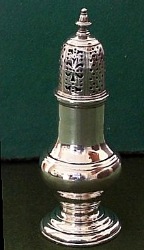 |
There was one further development affecting the baluster
caster and this became apparent towards the end of the 18th
century.
Casters were by now being almost mass produced and their quality
suffered. The silver used in their making was thin and
lightweight. This necessitated a much larger foot to give it
some stability and the "stem"’ between body and foot became
appreciably longer forming a pedestal. The piercing of the top
consists of simple holes with no attempt at decorative work.
These holes are still drilled through a diaper background but on
the example shown here no attempt has been made to line up the
holes with the diaper work and even the finial is just a simple
acorn shape.
These casters are undecorated and are now marked
on the body again just below the joint of body and
top. The marks will be in the order; Lion, Leopard,
Date, Duty. As with all other casters made later
than 1713 the marks appearing on the top are always
on the sleeve which pushes into the body and it is
surprising, given the number of times they have been
thus rubbed during their lifetimes, that they still
survive. Better quality casters were still made
during this period but they are not as common as the
cheaper variety. Incidentally the one illustrated
here came out of the Hester Bateman workshop and
shows that her work is not always of the highest
quality and certainly not worth paying a high price
for.
(right) Pedestal Caster by Hester Bateman
London 1789/90
|
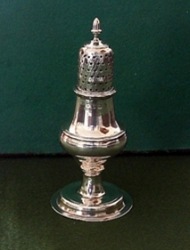 |
By the end of the century classical design had
had its affect on casters and they became urn shaped.
The top is still only perforated by simple holes but
with this design of caster the top takes on a double
bulbous appearance rather than a straightforward
dome and although the baluster finial persisted the
ball finial mentioned earlier can be found on these
casters.
As this classical design only appeared at the end of
the 18th century it persisted into the 19th.
(right) Late 18th century Classical Style
Caster
|
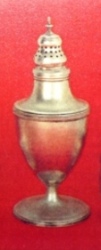 |
The progressive design of casters really came to
an end with this classical design and the 19th
century saw the evolution of the cruet set and the
introduction of novelty casters of all shapes and
sizes.
Sugar casters, which became glass vessels with
silver or plated tops became divorced from the
vessels made to contain pepper, and casters in sets
of three ceased to be produced. As with the bun
pepper the top of the glass caster fitted over the
neck of the vessel which was provided with a silver
collar to accommodate this push fit. Both this
collar and the bezel of the top which fitted over it
should be marked in the same way. The fly press was
used and the stub chosen was that used on tea tongs
with the marks in the order Duty mark, Lion, Date.
(right) Glass Caster with silver top by
Crispin Fuller 1796/7
|
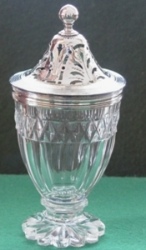 |
It has to be said that casters decreased in size during the
18th. century so that the Queen Anne caster by Charles Adam
London 1713/14 made for sugar (see top page) holds 3oz. whereas
the glass caster produced at the end of the century and also
made for sugar only holds 1¾oz. I am of the opinion that this
has more to do with the increasing cost of producing casters
than any change in the dietary habits of the people of the time
or, indeed, the cost of sugar.
It will be seen from the foregoing that the name caster, as used
by collectors, refers to vessels produced toward the end of the 17th
century and throughout the 18th and should therefore bear
hall-marks of this period. Any earlier marked examples are fakes
and are probably made from small tankards. In such cases, of
course, the tops will be unmarked. Any later ones, allowing that
the production of the urn shaped caster did spill over into the
19th century, are merely reproductions.
Although the foregoing text and illustrations, with the
exception of the 'Late 18th century Classical Style Caster',
are taken from actual items of plate and are representative they
are not definitive. Examples can be found, ornately decorated
casters by de Lamerie for instance, which do not conform to
these guidelines and they can, therefore, only be taken as a
guide to what to expect when seeking to establish the
development of these pieces of English social history.
David McKinley
- 2011 -
David McKinley devotes much of his time to researching
the history of silversmithing in England with particular
reference to hallmarking at the London office. He writes
for both The Silver Spoon Club of Great Britain and The
Silver Society.
|
|
 ASSOCIATION OF SMALL COLLECTORS OF ANTIQUE SILVER
ASSOCIATION OF SMALL COLLECTORS OF ANTIQUE SILVER






